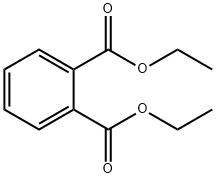
Diethylphthalat
Bezeichnung:Diethylphthalat
CAS-Nr84-66-2
Englisch Name:Diethyl phthalate
CBNumberCB3349654
SummenformelC12H14O4
Molgewicht222.24
MOL-Datei84-66-2.mol
Synonyma
Diethylphthalat
1,2-Benzoldicarbons?urediethylester
DEP
Diethylphthalat physikalisch-chemischer Eigenschaften
| Schmelzpunkt | -3 °C (lit.) |
| Siedepunkt | 298-299 °C (lit.) |
| Dichte | 1.12 g/mL at 25 °C (lit.) |
| Dampfdichte | 7.66 (vs air) |
| Dampfdruck | 1 mm Hg ( 100 °C) |
| Brechungsindex | n |
| Flammpunkt | >230 °F |
| storage temp. | 2-8°C |
| Löslichkeit | Practically insoluble in water, miscible with ethanol (96 per cent). |
| Aggregatzustand | Liquid |
| Wichte | 1.118 |
| Farbe | APHA: ≤15 |
| Geruch (Odor) | water-wh. oily liq., odorless, bitter taste |
| PH | 7-8 (20°C in H2O) |
| Biologische Quelle | synthetic |
| Explosionsgrenze | 0.75%, 187°F |
| Wasserlöslichkeit | 1 g/L (20 ºC) |
| Merck | 14,7371 |
| S-Sätze: | 24/25 |
| RIDADR | UN 3082 9 / PGIII |
| OEB | B |
| OEL | TWA: 5 mg/m3 |
| WGK Germany | 2 |
| RTECS-Nr. | TI1050000 |
| Selbstentzündungstemperatur | 854 °F |
| TSCA | Yes |
| HS Code | 29173400 |
| Giftige Stoffe Daten | 84-66-2(Hazardous Substances Data) |
| Toxizität | LD50 i.p. in rats: 5.06 ml/kg (Singh) |

